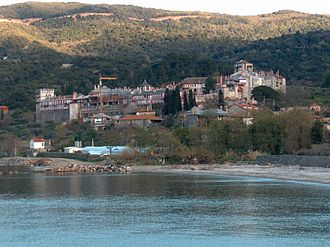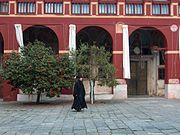The Holy and Great Monastery of Vatopedi on Mount Athos was built during the second half of the 10th century, by three monks, Athanasius, Nicholas, and Antonius from Adrianople, who were the pupils of Athanasius the Athonite. A legendary tradition says that its construction was ordered in the 4th century by Eastern Roman Emperor Arcadius to honour the miraculous salvation by the Virgin Mary of his son from a shipwreck. The child is said to have been found in a brier bush--hence Vato (brier) Paidi (child).
From then onwards several buildings have been constructed, most of them were built during the Byzantine period and during the 18th and 19th centuries when the monastery reached its highest peak.
About 50 monks live in the monastery today, where extensive construction projects are underway to restore the larger buildings.
It is closed for public view, but is open for scientists with the permission of the monastery and the 10th Ephorate of Byzantine Antiquities.
Sketes attached to Vatopedi
The following large Sketes are attached to Vatopedi: the Skete of Saint Andrew in Karyes and the Skete of Saint Demetrius near the main monastery. Other smaller sketes are also attached to the monastery.
Main buildings within the walls of the monastery
- The Katholikon, dedicated to the Annunciation of the Theotokos
- The Trapeza
- The Byzantine period clock tower
- The 10th century NE tower which now houses the monastery's library
Treasures held within the monastery
The Monastery of Vatopedi holds a belt held by believers to be the actual belt of the Virgin Mary, which she wore on earth and gave to Thomas the Apostle after her death and during her transition to heaven. The monastery also contains the Iaspis, a jasper communion cup fashioned of a single piece of the precious stone, and various other icons.
Vatopedi's library also preserves a medieval Bulgarian royal charter, the 13th-century Vatopedi Charter of Ivan Asen II of Bulgaria dedicated to the monastery. It was discovered in the monastery's archives in 1929.
Miracle working icons within the monastery
There are a number of icons considered to be miracle-working in the monastery. One of the most well-known is the icon of Panagia ("Pantanassa", or the "Queen of All"), which is held to work miracles, especially to cure cancer. A copy was made and sent to Russia; this copy is also believed to be miracle-working.



No comments:
Post a Comment